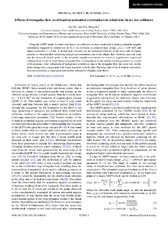| dc.creator | Xu, Jun | |
| dc.creator | Ko, Che Ming. | |
| dc.date.accessioned | 2011-09-13T21:26:32Z | |
| dc.date.available | 2011-09-13T21:26:32Z | |
| dc.date.issued | 2011 | |
| dc.identifier.citation | Jun Xu and Che Ming Ko. Phys.Rev.C 83 021903 2011. "Copyright (2011) by the American Physical Society." | en |
| dc.identifier.uri | http://dx.doi.org/10.1103/PhysRevC.83.021903 | |
| dc.identifier.uri | https://hdl.handle.net/1969.1/127124 | |
| dc.description | Journals published by the American Physical Society can be found at http://publish.aps.org/ | en |
| dc.description.abstract | Using the AMPT model for relativistic heavy ion collisions, we have studied the di-hadron azimuthal angular correlations triggered by emitted jets in Au + Au collisions at center-of-mass energy root s(NN) = 200 GeV and impact parameter b = 8 fm. A double-peak structure for the associated particles at the away side of trigger particles is obtained after subtracting background correlations due to the elliptic flow. Both the near-side peak and the away-side double peaks in the azimuthal angular correlations are, however, significantly suppressed (enhanced) in events of small (large) triangular flow or triangularity in the initial collision geometry as a result of fluctuations. After subtraction of background correlations due to the triangular flow, the away-side double peaks change into a single peak with broad shoulders on both sides. The away side of the di-hadron correlations becomes essentially a single peak after further subtraction of higher-order flows. | en |
| dc.language.iso | en | |
| dc.publisher | American Physical Society | |
| dc.subject | QUARK-GLUON PLASMA | en |
| dc.subject | NUCLEAR COLLISIONS | en |
| dc.subject | TRANSPORT MODEL | en |
| dc.subject | COLLABORATION | en |
| dc.subject | PERSPECTIVE | en |
| dc.subject | MATTER | en |
| dc.subject | Physics | en |
| dc.title | Effects of triangular flow on di-hadron azimuthal correlations in relativistic heavy ion collisions | en |
| dc.type | Article | en |
| local.department | Physics and Astronomy | en |


